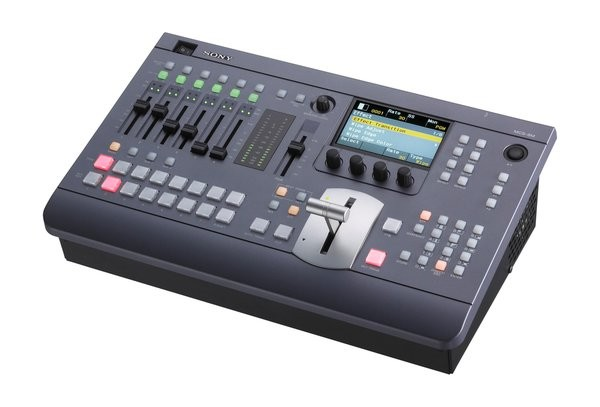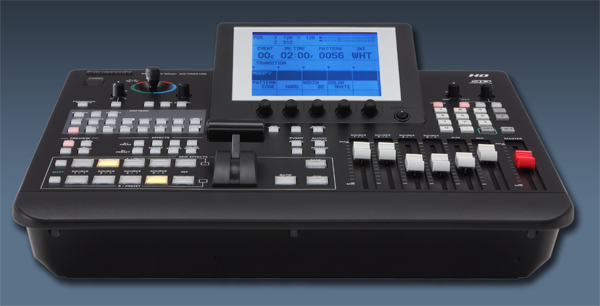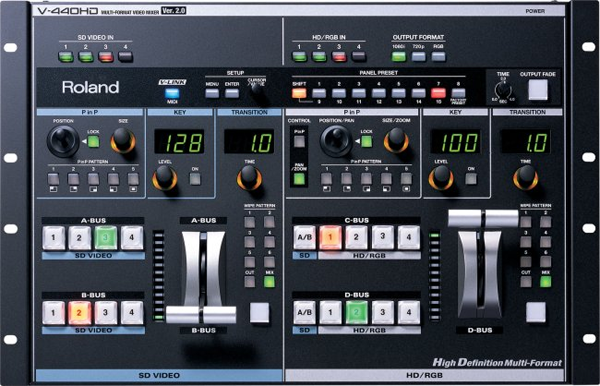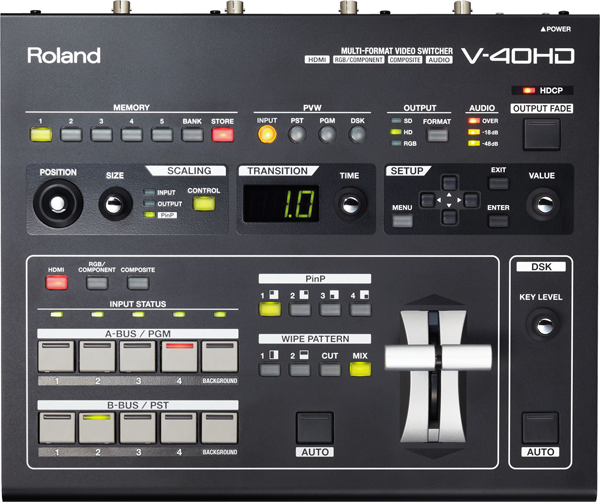Choosing HD Video Switchers for Webcasting--UPDATED!
This article is the fourth in a series on webcast video production and discusses video switchers, including the cost and features that differentiate several popular models.
Sony MCS8M Compact Audio Video Mixing Switcher ($5,395)
With 8 HD inputs (4 HD-SDI, 3 HDMI, 1 DVI) and 4 HD outputs (1 HD-SDI and 1 DVI program output and 2 AUX HD-SDI outputs), the Sony MCS8M (below) is the first of the traditional video switchers that I would consider for my own needs. I really like built-in audio delay feature.

Sony MCS8M Compact Audio Video Mixing Switcher
Audio inputs are always a challenge and consideration for video mixers and the Sony does not disappoint. It features both embedded HD-SDI and HDMI audio channels as well as a variety of mic and line-level XLR, 1/4", and RCA audio inputs.
Panasonic AG-HMX100 Digital AV Mixer ($5,711)
This Panasonic AG-HMX100 (below) is very similar to the Sony MCS8M in terms of features but offers one fewer HDMI video input and one fewer Aux bus. The HMX100 does have four pairs of XLR inputs, which is three more than the single pair on the Sony MCS8M but, overall, I feel the Sony model offers a better value.

Panasonic AG-HMX100
Roland V-440HD ($9,995)
The Roland V-440HD (below) is really two-in-one: An SD switcher on the left and an HD switcher on the right. What makes this switcher so special is that you can upconvert an SD signal on the left to the HD side. I think this workflow had its place a few years ago but I'd add an external upconverter to one of the less expensive previous models and pocket the difference or buy an audio mixer with it, as the V-440HD doesn't have any audio controls.

Roland V-440HD
The V-400HD is the only model on the list with a VGA input, but it's worth noting that the V440-HD lacks HDMI or DVI inputs so you will have to adapt a modern computer signal with a simple HDMI to HD-SDI converter. The V-440HD also lacks a multi-view output, so you'll need an HD-SDI monitor for each input.
Final Thoughts
Sorting through all the video switchers available to webcasters can be very complicated and I hope this article helps to sort out some of the differences. In terms of important features, I have found that having multiple program and Aux outputs was very important for my various live production and webast workflows, and that audio mixing capabilities should not be overlooked when comparing video mixers.
Author's Note and Update
Keeping on top of all the various models of HD video switchers is no easy task as technology changes at such a rapid rate. So when Roland announced a new HD video switcher that merits inclusion in this article on the very day that this article was published, I wasn't too surprised, especially seeing that their only other model that made this list dates back to 2005, which is an eternity in the video production business. The thought of having my latest article be instantly out of date was too much for me to bear, so I'm adding a summary of Roland's new model:
Roland V-40HD Multi-Format Video Switcher ($4,495 MSRP)
In the above article I mention that no model on my list has both VGA and HDMI inputs, which are important when working with the variety of computers and their respective connections. The Roland V-40HD (below) fills this need, although it does lack HD-SDI inputs.

A look at the Program and Preview Buses reveals four input channels but the Roland V-40HD is actually a 12-channel video mixer as each input channel can have an HDMI, VGA, and Composite connection and the input can be selected by one of the three Input Selector buttons above the Program and Preview Bus selector. Each input can either accept or be scaled to a maximum resolution of 1080 60P, making this the only 1080/60p video mixer on the list. Additionally each input can be duplicated and then independently scaled so that a single wide camera input can act as both a close-up and a wide angle—Roland calls this feature Multi-Zoom. A Quad View HDMI output provides an easy way to see the active video inputs on each of the four input channels on a single monitor.
Audio inputs come via external 1/4" connections, which then get embedded in the two HDMI outputs. A small three-LED display (Over, -18dB, and -48dB) helps to ensure you don't clip audio but otherwise begs for additional intervals. Audio delay for proper lip sync and Tally light outputs round out the features on the V-40HD. The Roland V-40HD will ship in January 2013.
Related Articles
In this ongoing Streaming Media Producer series on webcast video production, Shawn Lam covers the video format converters he uses in his own HD webcast workflows, and one new converter that just might be the video converter, scaler, and distribution amplifier to rule them all.
Now featuring a new interview from NAB 2013 on the Sound Devices Pix240i, this article looks at a handful of portable and rackmount external video recorders for live HD production, specifically in the role of recording the master program feed from a live switch.
The ATEM Television Studio is a software-driven video and audio mixer that, for less than $1000 (US), allows you to mix up to six cameras down into a single output program feed, live. You can also add keys, masks, and titles, and it features a built-in H.264 encoder that puts this little stick of tricks firmly on the webcaster's radar.
New switcher designed for live events and installations, augments V-1600HD and V-800HD lineup with 12 inputs on 4 channels plus 1 (background), and 2 output buses with independent scalers on the inputs and outputs allowing you to connect HDMI/DVI, RGB, component, and composite sources
Part 2 of this series on webcast video production focuses on Sony's NEX-FS100 large-sensor camcorder and new capabilities added via a firmware upgrade that (among other things) makes it compatible with Sony's LA-EA2 lens adapter. While it's not as strong a webcast camera as the FS700 (review coming soon), it still has much to recommend it.
This article will be the first in a series of articles on webcasting and will cover a wide range of topics including video cameras, video switchers, converters, computer inputs, audio, reference monitors, webcast hardware, webcast software, live streaming services providers, and some additional hardware that is important in order to produce a professional live webcast.